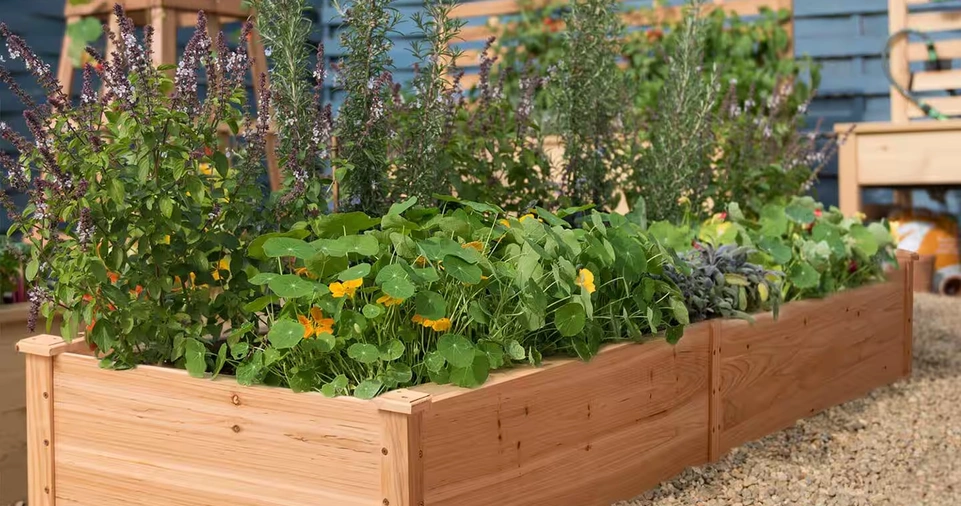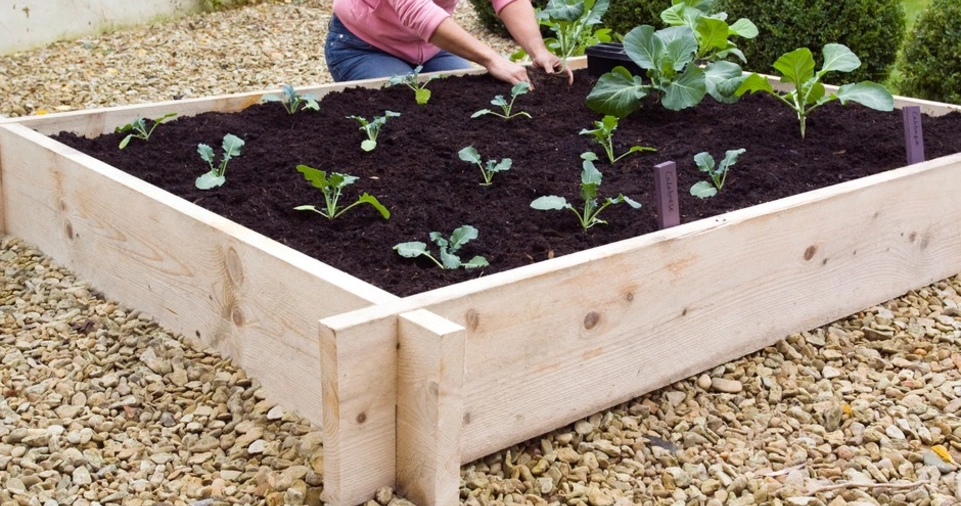A raised garden bed is a fantastic way to grow vegetables, herbs, and flowers while improving soil drainage and reducing weed growth.
Whether you have poor soil conditions or limited space, a raised garden bed provides a controlled environment that enhances plant health and yield.
In this comprehensive guide, we’ll walk you through the benefits, materials, step-by-step instructions, maintenance tips, and much more to help you build the perfect raised garden bed.
Benefits of Raised Garden Beds
Before diving into the construction process, it’s essential to understand why raised garden beds are an excellent choice for gardening:
- Improved Drainage: Excess water drains away easily, preventing root rot.
- Better Soil Control: You can customize the soil mix for optimal plant growth.
- Fewer Weeds: Raised beds have fewer weed infestations than traditional gardens.
- Easier Access: Less bending over reduces strain on your back and knees.
- Extended Growing Season: Soil warms up faster in the spring, allowing for earlier planting.
- Aesthetic Appeal: Enhances the look of your garden space.
- Pest Prevention: Elevating plants can deter some pests from reaching them.
- Soil Erosion Control: Helps retain soil and nutrients, especially in sloped areas.
Choosing the Best Materials
The choice of materials impacts the durability and performance of your raised garden bed. Here’s a breakdown of commonly used materials:
| Material | Pros | Cons |
|---|---|---|
| Cedar/Redwood | Naturally rot-resistant, long-lasting | More expensive than other woods |
| Pine | Affordable, readily available | Needs to be replaced sooner |
| Composite | Resistant to rot and weathering | Higher cost, may warp over time |
| Cinder Blocks | Durable, easy to assemble | Can retain too much heat |
| Galvanized Steel | Long-lasting, sleek appearance | Can be expensive, may overheat soil |
ALSO READ: How to Mix and Match Textures in Interior Design?
Step-by-Step Guide to Building a Raised Garden Bed

Step 1: Choose the Right Location
Selecting the right spot is crucial. Look for an area that:
- Receives at least 6-8 hours of direct sunlight daily.
- Has good air circulation.
- Is close to a water source for easy irrigation.
- Avoids heavy shade from trees or buildings.
- Has well-draining soil underneath.
Step 2: Determine the Size and Shape
Standard dimensions for raised beds are around 4 feet wide (for easy reach from both sides) and 6-8 feet long.
The height should be at least 12-18 inches deep to allow proper root growth. Taller beds (24 inches or more) are recommended for those with mobility issues or poor native soil.
Step 3: Gather and Cut Materials
Use a saw to cut wooden planks to your desired dimensions. Cedar and redwood are the best choices due to their rot-resistant properties.
Step 4: Assemble the Frame
- Arrange the cut wooden planks into a rectangular or square shape.
- Secure the corners with screws or nails.
- If needed, reinforce the structure with corner brackets.
- Double-check for alignment to ensure stability.
Step 5: Prepare the Ground
- Clear the area of grass and weeds.
- Level the ground using a rake.
- Lay down landscape fabric to prevent weeds from growing up into the bed.
- Consider adding a layer of gravel for better drainage.
Step 6: Fill with Soil
Mix compost, topsoil, and sand in equal parts to create a nutrient-rich soil blend. Fill the raised bed with this mixture, leaving about an inch from the top.
| Soil Component | Benefits |
|---|---|
| Compost | Provides organic matter and nutrients |
| Topsoil | Ensures proper root support |
| Sand | Improves drainage |
| Peat Moss | Retains moisture, balances soil structure |
Step 7: Water and Settle the Soil
- Lightly water the soil to help it settle.
- Add mulch on top to retain moisture and reduce weeds.
- Allow the soil to sit for a day before planting.
Best Plants for Raised Garden Beds

Raised garden beds are versatile and support various plant types. Here are some recommended choices:
| Vegetable | Growing Tips |
|---|---|
| Tomatoes | Requires staking and regular watering |
| Carrots | Prefers loose, sandy soil |
| Lettuce | Grows well in partial shade |
| Peppers | Needs warm temperatures and full sun |
| Radishes | Quick-growing and great for succession planting |
| Herbs | Basil, parsley, and mint thrive well |
| Strawberries | Space-saving and ideal for raised beds |
| Cucumbers | Needs trellising for vertical growth |
ALSO READ: How to Use Smart Home Devices to Simplify Your Life?
Companion Planting Tips
Companion planting helps improve growth and reduce pest issues. Here are some recommended plant pairings:
| Plant | Companion Plants | Avoid Planting With |
|---|---|---|
| Tomatoes | Basil, carrots, onions | Cabbage, potatoes |
| Carrots | Tomatoes, radishes | Dill, parsnips |
| Cucumbers | Peas, lettuce | Potatoes, sage |
Maintenance Tips for a Healthy Raised Garden Bed
To keep your raised bed in optimal condition, follow these maintenance tips:
- Regular Watering: Raised beds dry out faster than ground soil, so water consistently.
- Mulching: Apply a layer of mulch to conserve moisture and suppress weeds.
- Crop Rotation: Avoid planting the same crops in the same spot each season to prevent soil depletion.
- Fertilization: Use organic compost or slow-release fertilizers to enrich the soil.
- Weed Control: Check for weeds regularly and remove them before they spread.
- Pest Management: Introduce natural predators like ladybugs or plant pest-repelling flowers like marigolds.
Common Mistakes to Avoid

While building and maintaining a raised garden bed, avoid these common pitfalls:
- Using Treated Wood: Chemicals in treated wood can leach into the soil and harm plants.
- Poor Drainage: Ensure your bed has proper drainage to prevent waterlogging.
- Overcrowding Plants: Leave enough space for plant roots to spread and receive adequate airflow.
- Neglecting Soil Quality: Refresh the soil with compost and organic matter yearly.
- Not Considering Irrigation: Drip irrigation or soaker hoses can save time and water.
Additional Features to Consider
For a more efficient and aesthetic raised garden bed, consider these enhancements:
- Trellises: Ideal for climbing plants like beans and cucumbers.
- Cold Frames: Extend the growing season by providing frost protection.
- Automatic Watering Systems: Saves time and ensures consistent moisture.
- Decorative Edging: Enhances the garden’s look and prevents soil spillover.
Conclusion
Building a raised garden bed is a rewarding project that enhances your gardening experience by improving plant health, reducing maintenance, and increasing yields.
With the right materials, location, and care, you can create a thriving garden that produces fresh, healthy crops season after season.
Whether you’re growing vegetables, herbs, or flowers, a raised garden bed offers a structured and efficient way to cultivate plants. Happy gardening!







